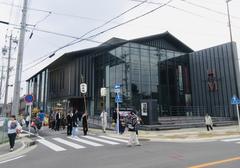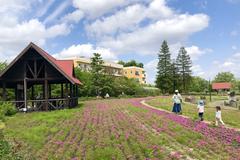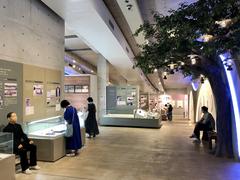
Kamezaki Station: Visiting Hours, Tickets, and Nearby Attractions in Handa, Japan
Date: 03/07/2025
Introduction
Nestled in Handa City, Aichi Prefecture, Kamezaki Station is a living testament to Japan’s Meiji-era railway heritage and the region’s vibrant culture. As the oldest actively used wooden station building in Japan, dating back to 1886, Kamezaki Station offers more than just a transit point—it is a gateway to Handa’s industrial legacy, traditional festivals, and an array of historical sites. Whether you are fascinated by railway history, eager to participate in local events, or planning a cultural exploration in Aichi, this detailed guide provides all the essential information for your visit, including operating hours, ticketing, accessibility, travel tips, and attractions nearby. (Wikipedia, Japan Rail Club, Audiala, Aichi Now)
Table of Contents
- Historical Overview
- Visitor Information
- Getting to Kamezaki Station
- Nearby Attractions
- Seasonal Events and Festivals
- Practical Visitor Tips
- Dining, Shopping, and Accommodation
- Frequently Asked Questions (FAQ)
- Visual & Media Suggestions
- Conclusion and Call to Action
- Sources
Historical Overview
Origins and Development
Kamezaki Station opened on March 1, 1886, during Japan’s transformative Meiji era. Originally part of the Japanese Government Railways (JGR), it connected the Taketoyo Line to the broader national network, facilitating both passenger and freight transport that supported Handa’s brewing industries and commerce. Its establishment marked the city’s evolution from a port town to an important industrial hub. (Wikipedia, Japan Rail Club)
Architecture and Preservation
After a fire in 1895, the station was rebuilt in its now-iconic wooden form. The building’s Meiji-era architecture—characterized by a tiled roof, large windows, and traditional joinery—has been meticulously maintained and is recognized as the oldest actively used wooden station in Japan. Modern updates, including a footbridge (added in 2014) and automated ticketing machines, ensure convenience while preserving historic integrity.
Role in Regional Growth
Kamezaki Station was instrumental in transporting local sake and vinegar to larger markets, supporting Handa’s economic expansion. Though freight services ceased in 1975, the station remains a vital commuter hub, connecting Handa to Nagoya and the wider Chita Peninsula. (Audiala)
20th Century Changes
Following the postwar transition from Japanese Government Railways to Japan National Railway (JNR), and later the 1987 privatization to JR Central, the station has continuously adapted. Automated ticketing (introduced in 1992) and the TOICA card system (2006) have enabled unstaffed operation while maintaining accessibility for travelers. (Wikipedia)
Cultural Significance
Beyond its function as a transit point, Kamezaki Station is a treasured symbol of local identity. It serves as the primary access point for the annual Kamezaki Shiohi Festival, a UNESCO-listed event featuring ornate floats paraded at low tide. The station’s proximity to the Handa Canal, black-walled brewing warehouses, and the Mizkan Museum makes it an ideal base for cultural exploration. (Aichi Now, Audiala)
Visitor Information
Station Hours & Ticketing
- Operating Hours: The station is open daily, from early morning until the last train in the evening, in line with the JR Taketoyo Line schedule.
- Ticketing: Automated machines are available during operating hours. TOICA contactless cards are accepted for convenient travel.
- Fare Example: One-way fare from Nagoya Station to Kamezaki Station is approximately 500 yen.
- Note: No admission ticket is required to enter the station building itself; tickets are required for train travel.
Accessibility
- Physical Access: Platforms are connected by stairs; the station does not have elevators or ramps. Wheelchair accessibility is limited. Contact JR Central in advance for assistance if needed.
- Facilities: Basic services include ticket machines, coin lockers, and waiting areas. English-language signage is limited, so using a translation app is helpful.
Travel Tips
- Plan your visit during daylight hours to appreciate the building’s architecture.
- Arrive early for festivals to avoid crowds.
- Bring cash for local purchases—some shops may not accept credit cards.
- Download the Audiala app for maps, guided tours, and up-to-date event info.
Getting to Kamezaki Station
- By Train: From Nagoya Station, take the JR Taketoyo Line, transferring at Obu Station. The journey takes about 30 minutes. (Handa City Tourism Guide, p.11)
- By Car: Accessible via the Chita Peninsula Road and Nagoya Expressway. Public parking is available near the station.
- From Chubu Centrair International Airport: Approx. 45 minutes by bus or 15 minutes by car.
Nearby Attractions
1. Handa Red Brick Building (Handa Akarennga Tatemono)
- Distance: 20 minutes on foot or short bus ride
- Hours: 9:00 AM – 5:00 PM (Closed Mondays)
- Admission: Free
- Registered cultural property; features local history exhibits and a café. Wheelchair accessible.
2. Mizkan Museum
- Distance: 25-minute walk or short taxi ride
- Hours: 9:30 AM – 4:30 PM (Closed Wednesdays)
- Admission: Adults ¥300, Children ¥150, free for under 6
- Interactive vinegar brewing museum with English audio guides. (Mizkan Museum)
3. Kunizakari Sake Cultural Hall (Nakano Sake Brewery)
- Distance: About 2 km
- Hours: 10:00 AM – 4:00 PM (Closed Sundays)
- Admission: ¥500 (guided tours, includes tastings)
- Learn about sake brewing and sample local varieties.
4. Kamizaki Shrine
- Distance: 15-minute walk
- Admission: Free, open daily
- Central to the annual Shiohi Festival and local spirituality.
5. Handa Canal Area
- Scenic walking/cycling route lined with historic kura warehouses; best visited during cherry blossom season.
6. Nankichi Niimi Memorial Museum
- Distance: 30-minute walk or short bus ride
- Hours: 9:00 AM – 5:00 PM (Closed Mondays)
- Admission: Adults ¥300, Children ¥150
- Literary museum with park and interactive exhibits.
7. Handa City Museum
- Distance: Short bus ride
- Hours: 9:00 AM – 5:00 PM (Closed Mondays)
- Admission: Adults ¥400, Children ¥200
- Local history and art exhibits. (Handa City Museum)
Seasonal Events and Festivals
Kamezaki Shiohi Festival
- Dates: May 3–4 annually
- UNESCO Intangible Cultural Heritage festival with ornate floats paraded from Kamizaki Shrine to the beach at low tide.
- Accessible with assistance; expect large crowds.
Handa Spring Festival
- March–May: Neighborhoods host 31 floats, puppetry, and lion dances.
Sake & Vinegar Heritage Events
- Year-round brewery tours and tastings at sites like Kunizakari and Mizkan.
Practical Visitor Tips
- Tourist Information Center: Located at Ai Plaza Handa, a five-minute walk from the canal. Open 8:30–17:30; English materials available.
- Bicycle Rental: 300 yen (3 hours), 500 yen (all day); available at the tourist center.
- Luggage Storage: Coin lockers at the station and tourist center.
- Souvenirs: Local crafts and specialty foods available in nearby shops.
- Safety: Dial 119 for emergencies (fire/medical) or 110 for police. (Handa City Tourism Guide, p.11)
- Etiquette: Respect the quiet residential atmosphere and ask permission before photographing people or private property.
Dining, Shopping, and Accommodation
- Dining: Limited options at the station; more variety near the Handa waterway and city center, featuring local seafood and sake.
- Accommodation: Several hotels within a 10–15 minute taxi ride, including Hotel Arc Handa Branch, Candeo Hotels Handa, Business Hotel Kotobukiya, and Sunport Hotel Handa.
Frequently Asked Questions (FAQ)
Q: What are the opening hours of Kamezaki Station?
A: The station operates from early morning until the last train in the evening, aligned with the Taketoyo Line schedule.
Q: How do I buy tickets?
A: Use automated ticket machines or TOICA cards at the station.
Q: Is the station accessible for wheelchair users?
A: Accessibility is limited due to stairs; contact JR Central in advance for assistance.
Q: When is the Shiohi Festival held?
A: Annually, May 3–4.
Q: Where can I get tourist information?
A: At Ai Plaza Handa, open 8:30–17:30, near the canal.
Visual & Media Suggestions
- Images: Historic wooden station building (alt: “Kamezaki Station historic wooden building”), Shiohi Festival floats (alt: “Shiohi Festival Dashi floats in Kamezaki”), Handa Canal, museums, and local streets.
- Video: Short tour of the station and festival atmosphere.
- Maps: Walking routes from Kamezaki Station to main attractions.
Conclusion and Call to Action
Kamezaki Station is more than a historic railway stop—it is the heart of Handa’s cultural and industrial heritage. From the timeless charm of its Meiji-era station building to the vibrant energy of the Shiohi Festival and the wealth of nearby attractions, this destination offers a unique blend of tradition and modernity.
Plan your journey: Check train times, secure your tickets, and explore Handa’s historic sites. For the latest updates, event info, and guided tours, download the Audiala app and follow our social media channels for travel inspiration and insider tips.
Sources
- Wikipedia: Kamezaki Station
- Japan Rail Club: Historical Train Stations
- Audiala: Handa, Japan
- Aichi Now: Kamezaki Shiohi Festival
- Handa City Tourism Guide
- Guidoor: Kamezaki Station
- JapanLiburan: Handa City
- Mapcarta: Kamezaki Station
- Mizkan Museum
- Handa City Museum





